Water Injection
-
- A broader-based payback from R&D Maritime Reporter, Mar 2000 #8
Consolidation in the diesel engine building sector is partly a reflection of the substantial capital expenditure required to maintain product development and technological advance in a business characterized by comparatively low unit margins.
By spinning-off new technical solutions arising from the engine design program into upgrading and conversion packages for existing populations of machinery, the manufacturer and licensor can gain more from R&D endeavors. Complementing new engine sales, product releases aimed at plant already in operation represents another stream of payback on heavy investment in technology.
The companion effect of the strategy, of course, is the broader benefit it brings to the client market, enabling gains in performance to be readily harnessed in existing operations.
As part of the thorough restructure implemented in 1998, full-line engine producer Wartsila NSD Corporation elevated aftersales service to the status of a business area in its own right, to create a growing earnings base. Not only does the sector generate some 25-26 percent of overall group earnings, its activities and results provide a stabilizing influ- ence in the face of volatility in the marine and landside markets for new machinery.
Under the direction of group vice-president Tage Blomberg, the service business area has augmented the traditional back-up activities with a dynamic approach to the development of what are termed as service prod- ucts. While this is reflected in an increasing range of support agreements, to meet rapidly evolving market needs, and while it is also manifested in a growing suite of maintenance and diagnostic software, it is additionally evident in the release of technology products for modifying existing engines.
Every development of a product generates new technical solutions, improved design and optimized processes. Upgrading is an economical method of injecting new life into older engines and installations, making the advances in reliability and efficiency otherwise vested in new machinery accessible to the existing engine base.
It is a concept that is attracting increasing interest from customers.
Among the latest releases are a bevy of nitrogen oxide (NOx)-reduction measures targeted at plant already in operation. Shipowners can accordingly upgrade older Wartsila Vasa 32 engines to the emissions-performance obtained with the successful Vasa 32LN design, reducing the NOx value below IMO-prescribed limits while also securing reduced specific fuel consumption. Other packages offered as retrofits are the Direct Water Injection (DWI) and Selective Catalytic Reduction (SCR) secondary methods of treatment.
In the two-stroke domain, the company also plans to make a new standard in piston- running technology available for application to existing Sulzer RTA engines.
The clutch of design modifications encapsulated by TriboPack promises significant extensions to times between overhauls (TBOs), a key element being the new chromi- um-ceramic top piston ring. The TriboPack improvements are being implemented as standard design changes in all newly-developed types, such as the Sulzer RTA68T-B and RTA60C lowspeed models, and will also come into play on larger-bore RTA machinery and progressively also as a retrofit package.
Carnival, Wartsila Clearing The Air As the world's cruise lines grow exponentially larger and are increasingly falling under the gaze of environmental and regulatory bodies, the push to ensure that ships are run safely, efficiently and environmentally sound gains new importance each day. The world's largest cruise ship company — Carnival Corporation (CCL) — has hooked up with one of the premier builders of marine diesel engines — Wartsila NSD — to develop a smokeless diesel-electric propulsion system for cruise ships.
Code-named "project enviroengine," prototypes of the new engine are expected to be available later this year for laboratory testing and are expected to be available commercially in 2001. Following successful completion of testing, Carnival plans to utilize those engines on its future newbuilds.
According to Captain Jim Drager, Carnival's vice president of corporate shipbuilding, when complete, the enviroengine, installed in a diesel-electric propulsion system, will be one of the most environmentally friendly power plants available for ships. "We have studied the attributes of gas turbines, which we are considering installing on several Carnival Corporation newbuilds now under contract, but still believe that eventually our current diesel-electric systems can be as environmentally friendly as gas turbine alternatives," he said. Drager pointed out that because of efficiency, diesel-electric systems are far less taxing on precious fossil fuel assets and also emit substantially less carbon dioxide to the atmosphere, which is the number one contributor to global warming.
According to Daniel Paro. Wartsila's group vice president - technology, the enviroengine is being created by combining "common rail technology" with a direct water injection system. Common rail technology uses an electronically controlled method to inject the precise amount of fuel at exactly the right time, resulting in greater engine operating efficiency and virtually eliminating smoke emissions.
Direct water injection reduces nitrous oxide emissions by spraying water into the combustion chamber to cool it down immediately prior to injecting the fuel.
Cooling down the chamber reduces nitrous oxide formation, which occurs at high temperatures. This method reduces nitrous oxide emission value to the same level as gas turbine engines.
Paro said, "The cruise industry has made its desire to have the most environmentally friendly ships sailing the seas well-known to its suppliers, and we are happy to have Carnival working with us on this exciting development. Since the mid-1980s, Wartsila NSD has spent more than $100 million (U.S.) on emission reduction research." He added that Wartsila will have spent more than $10 million (U.S.) on the enviroengine development before the prototype testing models are even built.
Drager said that in addition to being utilized on future newbuild orders, power plants on several vessels currently under construction, including Carnival Cruise Lines' "Spirit-class" ships and the Costa Atlantica, could be converted to the enviroengines. Additionally, Carnival plans environmental conversions on several of its existing vessels, including Holland America's Alaska-based ships.
"Direct water injection technology, and the smokeless feature of the new enviroengine once perfected, will provide substantial environmental advantages," Drager said.
Delivering the technology A more commercially-inspired approach to the crucial subject of research and development can be expected to ensue from the dramatic reorganization set in train at Lloyd's Register. Prompted by the past few years' sharp deterioration in financial results, chairman David Moorhouse has instituted a far-reaching overhaul and streamlining of the society. His immediate aims are to rein back losses averaging out at $3.2 million per month, and reach breakeven by 2002.
Major cuts in the central establish- ment, much increased regional control and enhanced operating flexibility and customer responsiveness are corner- stones of the program. Moorhouse.
though, is acutely conscious of the need maintain a vigorous R&D program and ensure the capability to offer clients 'added-value' through technological prowess, at a time when every element of internal cost is being scrutinized.
In recent years, the R&D endeavor in its manifold forms has consumed some $12.8 -14.4 million annually, the bulk of which has involved the maritime dis- ciplines. While there is a sustained, high-level commitment to research, the shape and composition of the program in the future will be determined by closer scrutiny of the application scope for the technology concerned, and by consideration of prospective results. The indications are that efforts will be far more results-oriented than in the past.
Most importantly, LR's accent on improving the way in which it delivers service to its customers, as manifested in the new organizational framework, should ensure the increased effectiveness of technological efforts. Significantly, R&D activities will be ultimately overseen by the director in charge of the newly-created marine business stream.
Concerns at the sharp end The trend towards generally faster mercantile vessels, coupled with design evolution, calls for closer attention to the structural integrity of ships' forebodies.
Classification society Germanischer Lloyd brought in tougher standards for containerships last year, in the light of an increased incidence of forebody damage, while the Europe Union-sponsored Dextremel research project is addressing the effects of extreme waves on foredecks and b ow doors.
Polish Register of Shipping (PRS) is also planning to introduce new criteria governing bow integrity, prompted by occurrences of bow damage and ship loss associated with impact load forces.
"Ship safety standards are normally verified using experience gathered in the past, which means that new designs or concepts are not always covered by existing standards," observed Jan Jankowski, director and managing director of PRS' marine branch. Accordingly, it is felt that increased responsiveness has to be demonstrated towards developments in ship design, calling where necessary for a changed approach by societies towards safety standards formulation.
Not only the adoption of higher power concentrations to achieve the faster sustainable speeds and scheduling dependability demanded by the industry, but also the tendency towards blunt bows, large forebody flare angles and finer underwater shapes, bear on the nature and effect of the structural loads imposed when moving through waves, in moderate as well as rough sea conditions.
-
- Production Floaters Orders Are on the Rebound Maritime Reporter, Mar 2018 #50
be VLCC-size (1.4 million bbls storage) and have capability to produce 180,000 b/d oil, 212 mmcf/d gas (which will be re-injected) and 240,000 b/d water injection. Ca Rong Do FPSO - In April 2017 Yinson Production finalized a contract to supply an FPSO to Repsol for use on the Ca Rong Do oil/gas discovery
-
- Norway's Rising Subsea Stars Marine Technology, Aug 2016 #42
of the beleaguered oil and gas industry: Wind-Powered Oil Recovery. Specifically the plan is designed to use floating wind turbines to power a water injection system. JIP partners include ExxonMobil, ENI Norge, Nexen Petroleum UK Ltd., Statoil, VNG Norge, PG Flow Solutions and ORE Catapult. “We can
-
- Coflexip Stena Awarded $58 Million Contract Maritime Reporter, May 2000 #16
of all the subsea structures and control system, including a manifold with six production wells gathered around, as well as two satellite water injection wells. The engineering, manufacturing and installation of all the flowlines (rigid reeled, pipe in pipe, flexible) and umbilicals for the
-
- HHI Wins $230-Million Offshore Project For ONGC In India Maritime Reporter, Oct 1988 #10
, fabrication, transportation, installation, hookup and commissioning at a total cost of $230 million on a cash basis. The project calls for one water injection platform with 160,000 bbl/d of seawater treatment capacity, one gas compression platform that can treat 2.4 million cubic meters of gas per
-
- T e n v i g Offshore A.S Develops Low-Cost Early Oil Production Ship Maritime Reporter, May 1980 #39
mooring. It comprises two or more decks on which all highpressure processes are arranged, i.e., first stage separation as well as gas and water injections. Consequently, all transfers between the stationary turret and the rotating ship are arranged via flexible hoses under low pressure. In
-
- Wartsila, Marioff To Cooperate On Emission Control Technolgy Maritime Reporter, Apr 2001 #65
is a specialist in creating humidity, while Wartsila needs humidity for reduction of NOx in diesel, and perhaps gas engines. The introduction of water into the combustion space of a diesel engine in one way or another reduces NOx formation. There are two main mechanisms for this phenomenon, one
-
- Launching, Double Christening At Flender Werft Maritime Reporter, Jan 2002 #12
of totally 48,000 kW via double gear onto two CP propeller systems. In order to reduce exhaust gas emissions, the main engines are equipped with a water injection device. Service speed of the ships will be nearly 30 knots, while full speed will be more than 31 knots. Two semi-balanced rudders as well
-
- Wartsila EnviroEngines For P&O Princess Cruises Maritime Reporter, Jan 2002 #45
no visible smoke at any load and when starting or during transient load changes. The engines also employ electronically controlled direct water injection to achieve the low NOx emission value of 6 g/kWh. These EnviroEngines for P&O Princess Cruises are the first to incorporate both technologies
-
- Omnithrusters installed In Variety Of Canadian Government Vessel Types Maritime Reporter, May 1986 #59
ice away from the vessel and its main propellers. Also, with optional Omniphaser units, the system can be used for ice lubrication by air/water injection around the hull. Omnithruster systems are currently installed in vessels of many types from tugs, barges and fishing boats to icebreakers
-
- Versatile FPSO Manifold System Eliminates Fluid Swivels Maritime Reporter, Aug 15, 1985 #7
,000 barrel (19,000-cubic-meter) per day SRM that includes 6,000 (410 bar) gas injection and annulus lines, as well as a 4,000 psi (275 bar) water injection line. For further information on the Mobil SRM, including its applicability to specific offshore producing operations, Circle 10 on Reader
-
- Lankhorst Mooring Ropes for Western Isles Development FPSO Marine Technology, Apr 2014 #58
the Northern North Sea, 160km east of the Shetlands and 12km west of Tern field. It involves a subsea development of at least five production and four water injection wells plus two exploration wells tied back to a new build floating production, storage and offloading vessel (FPSO) with oil export using shuttle
-
 )
March 2024 - Marine Technology Reporter page: 44
)
March 2024 - Marine Technology Reporter page: 44signed a partnership agreement with Cellula Ro- the CARIS Ping-To-Chart work? ow, allowing for full above- botics, USA Inc., to expand uncrewed underwater vehicle and-below- water image capture with survey grade accuracy (UUV) capabilities for advanced operations in dynamic envi- 44 March/April 2024 MTR
-
 )
March 2024 - Marine Technology Reporter page: 43
)
March 2024 - Marine Technology Reporter page: 43a new generation of GeoAcoustics sub-bottom with Cathx Ocean that it says ‘radically’ reduces the time and pro? ling technology, reaching into deeper waters for the ac- effort required to detect and classify objects of interest in sea- quisition of essential data for e.g., the development and opera- bed
-
 )
March 2024 - Marine Technology Reporter page: 42
)
March 2024 - Marine Technology Reporter page: 42Nano connector which offers a versatile and robust performance, making it suitable for multiple applica- tions and the increasingly compact design of underwater in- struments, equipment and systems. This splash and wet-mate connector is manufactured from high-grade titanium and neo- prene to withstand deep
-
 )
March 2024 - Marine Technology Reporter page: 41
)
March 2024 - Marine Technology Reporter page: 41Technology Image courtesy Exail Image courtesy Submaris and EvoLogics Vehicles The ROV-1500 from Outland Technology represents a leap forward in underwater robotics, a compact remotely operated vehicle (ROV) weighing in at less than 40 lbs (19kg) the ROV- 1500 is easy to transport and deploy. Similar
-
 )
March 2024 - Marine Technology Reporter page: 40
)
March 2024 - Marine Technology Reporter page: 40(ROTVs), inspection-class Remotely Operated Vehicles to withstand the most severe ocean conditions, the new DriX (ROVs), as well as Autonomous Underwater Vehicles (AUVs). O-16 has been designed for long-duration operations (up to Its gondola, located below the surface, can further host a wide 30 days)
-
 )
March 2024 - Marine Technology Reporter page: 36
)
March 2024 - Marine Technology Reporter page: 36is two-fold: 1) battery packs carried on the as valve regulated lead acid (VRLA), maintenance free de- outside of a pressure housing only subtract their water weight signs. Lead-acids are temperature dependent, and their capac- from the overall buoyancy, while carried inside, they subtract ity may fall
-
 )
March 2024 - Marine Technology Reporter page: 35
)
March 2024 - Marine Technology Reporter page: 35including common alkaline cells, cannot be lithium, contained inside a thin stainless-steel cylinder, is ex- pressure compensated. tremely reactive with water. Physical Modi? cations to a battery, including means to pres- ? Lithium-ion: These secondary cells are not subject to sure compensate the cells
-
 )
March 2024 - Marine Technology Reporter page: 33
)
March 2024 - Marine Technology Reporter page: 33Over the past four years, SMD has worked with Oil States Industries to calculate cost per tonne ? gures for prospective customers. Patania II uses jet water pumps to Oil States’ Merlin riser systems were lift nodules into a collection drum. successfully deployed on both the TMC / Allseas and JAMSTEC
-
 )
March 2024 - Marine Technology Reporter page: 30
)
March 2024 - Marine Technology Reporter page: 30to enable 3D visualization of op- The collector’s front-mounted Coandã-effect nozzles guide erations in real time. AI modelling can then determine the water over the seabed, creating negative pressure and a suc- environmental impacts of the operation and test how, for tion effect that picks up nodules
-
 )
March 2024 - Marine Technology Reporter page: 29
)
March 2024 - Marine Technology Reporter page: 29, sediment smothering and noise pollution. However, the International Seabed Au- thority (ISA) has granted 31 exploration contracts in international waters and is ex- pected to con? rm mining guidelines this July, or perhaps next. Nearly two thirds of the licenses are for nodule mining, the most advanced
-
 )
March 2024 - Marine Technology Reporter page: 25
)
March 2024 - Marine Technology Reporter page: 25, according to a tivity, and hydrophones to study activity against samples gathered by RV Tanga- NIWA statement from November 2022. that couples into the water column.” roa outside the caldera.” In all, Maxlimer Tonga’s severed domestic internet cable mapped more than 800 km2 and travelled was buried under
-
 )
March 2024 - Marine Technology Reporter page: 23
)
March 2024 - Marine Technology Reporter page: 23are largely unknown, in contrast with their sub-aerial (above-ground) counterparts. Kevin Mackay, marine ge- ologist at the National Institute of Water and Atmosphere Research (NIWA), New Zealand, said, “There are over one million underwater volcanoes, although only about 120 are known to have been
-
 )
March 2024 - Marine Technology Reporter page: 16
)
March 2024 - Marine Technology Reporter page: 16CATHODIC PROTECTION SURVEY USING NON-CONTACT SENSORS By Svenn Magen Wigen, FORCE Technology he principle behind sacri? cial anodes, which are water structures, reducing the need for frequent repairs and used to safeguard underwater pipelines and struc- replacements, which also aligns well with
-
 )
March 2024 - Marine Technology Reporter page: 15
)
March 2024 - Marine Technology Reporter page: 15. Engineering and Mechatronics at Villanova And for users who tend to operate in areas with drastic University and a Master of Engineering changes in water density, strong currents, and storm condi- in Systems Engineering and Project tions – such as the Gulf of Mexico or the Indian Ocean – the Management
-
 )
March 2024 - Marine Technology Reporter page: 14
)
March 2024 - Marine Technology Reporter page: 14TECH FEATURE TELEDYNE SLOCUM GLIDERS to hold over 3.5 times as many lithium primary batteries as the the water column and its thrusters give it the ability to stay standard Slocum Glider, and to physically accommodate up to on track in strong currents or other dif? cult ocean condi- 8 different sensor
-
 )
March 2024 - Marine Technology Reporter page: 13
)
March 2024 - Marine Technology Reporter page: 13nyone familiar with glider hardware options integrated for a broad Glider answers that need,” said Shea autonomous underwater ve- range of missions. Quinn, Slocum Glider Product Line hicles (AUVs) is certainly “As the use of Slocum Gliders grew, Manager at TWR. A familiar with the popular- so did
-
 )
March 2024 - Marine Technology Reporter page: 9
)
March 2024 - Marine Technology Reporter page: 9laser detection systems can detect mines just below the mines, as well as their locations, remains largely a mystery, surface, even those hiding in murky water. The Airborne Laser although reports suggest that over three hundred have been Mine Detection System (ALMDS) from Northrop Grumman deployed off
-
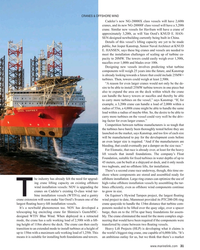 )
April 2024 - Maritime Reporter and Engineering News page: 31
)
April 2024 - Maritime Reporter and Engineering News page: 31, that race is already over, at least for the heavy lift vessels that install foundations. The company’s Float Foundation, suitable for ? xed turbines in water depths of up to 45 meters, can be built at a shipyard or dock, and it only needs two tugboats, and no offshore lifts, for installation. There’s a
-
 )
April 2024 - Maritime Reporter and Engineering News page: 27
)
April 2024 - Maritime Reporter and Engineering News page: 27at a time. We have six T-AGS oceanographic survey academies are graduating mariners into the workforce. But ships that perform a wide range of underwater science, research those graduates have choices. They can go on active duty and surveys, and a pair cable laying and repair ships. Our navi- with
-
 )
April 2024 - Maritime Reporter and Engineering News page: 13
)
April 2024 - Maritime Reporter and Engineering News page: 13confusing. Is there are straightforward approach that avoids these pitfalls? FOR SALE BY ONLINE AUCTION Land improved with 2,700sf - 3 bed - 2 bath. Water frontage and À oating dock For bidding information call: 617-565-5700 www.realestatesales.gov www.marinelink.com 13 MR #4 (1-17).indd 13 4/5/2024
-
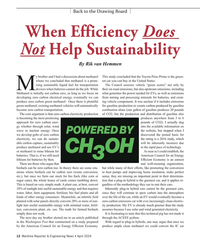 )
April 2024 - Maritime Reporter and Engineering News page: 12
)
April 2024 - Maritime Reporter and Engineering News page: 12they use to rate their cars. 10% of sunlight into useful sustainable energy and that requires Inherently plug-in hybrid cars cannot be the greenest cars, water, labor, farm equipment, fertilizer, bio fuel plants and all since they will continue to spew carbon into the atmosphere kinds of other energy consumers
-
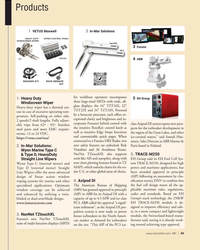 )
April 2024 - Marine News page: 43
)
April 2024 - Marine News page: 43as intuitive Edge Swipe functions the region of the Great Lakes, and other ments. 12 or 24 VDC. and customizable quick pages. When ice-covered waters,” said Samuli Hän- https://vetus.com/usa/ connected to a Furuno DRS Radar, two ninen, Sales Director at ABB Marine & new safety features are unlocked:
-
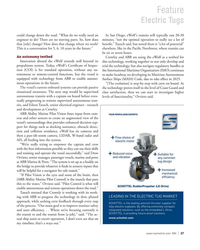 )
April 2024 - Marine News page: 37
)
April 2024 - Marine News page: 37for safe transit.” “If Pilot Vision is the eyes and some of the brain, then [ABB Ability Marine Pilot Control] is the muscle that puts this to the water,” Orvieto said. “Pilot Control is what will enable autonomous and remote operations down the road.” Tausch stressed that Crowely is working with its
-
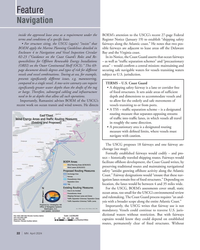 )
April 2024 - Marine News page: 22
)
April 2024 - Marine News page: 22This 69- areas” – would con? rm a central mission: maintaining and page document details degrees and types of risk for different securing safe navigable waters for vessels transiting waters vessels and vessel combinations. Towing at sea, for example, subject to U.S. jurisdiction. presents signi? cantly
